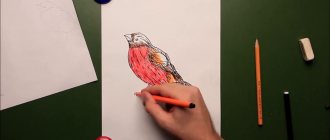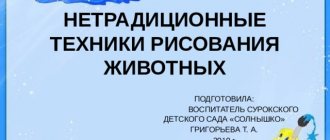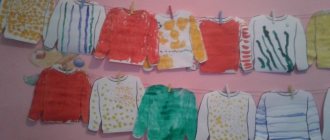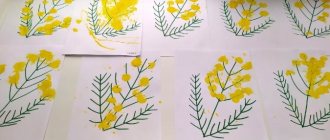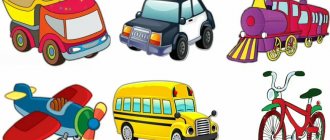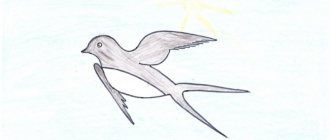Lesson 22. Drawing according to plan
Program content.
Teach children to independently choose the theme of their drawing, bring their plans to completion, hold a pencil correctly, and paint over small parts of the drawing. Develop creativity and imagination.
Methodology of conducting the lesson.
Invite the children to think about what each would like to draw. Say that you can draw trees, bushes, benches and ladders in the kindergarten area; toys that children play with.
During the lesson, encourage an interesting idea, stimulate the addition of drawings with images that are suitable in meaning. Ask questions that encourage you to expand your idea.
When viewing the drawings, invite the children to choose the most interesting ones, and ask those who drew them to tell about them. Praise the guys who conceived and implemented the most interesting images.
Materials.
White paper 1/2 landscape sheet size, colored pencils (for each child).
Connections with other activities and activities.
Observations at the kindergarten site. Games in the play corner, reading books, looking at illustrations. Conversations about what interesting things the children saw that can be conveyed in a drawing.
Lesson 23. Application “Big House”
Program content.
Strengthen the ability to cut a strip of paper in a straight line, cut off corners, and compose an image from parts. Learn how to create an applique image of a large house. Develop a sense of proportions and rhythm. Reinforce techniques for careful gluing. Teach children to see an image when looking at work.
Methodology of conducting the lesson.
Invite the children to cut out and paste a large house (2-3 floors). Clarify the appearance of the house, its parts: roof, windows, doors, their location. Offer to think about how to cut windows, doors, and roofs from strips, and explain if necessary.
At the end of the work, put the images on the board, admire how many houses there are - several streets, a whole city.
Materials.
Paper 1/2 the size of a landscape sheet, rectangles of colored paper in light colors (different for all tables) and strips of colored paper for windows, doors, roofs; scissors, glue, glue brush, napkin, oilcloth (for each child).
Connections with other activities and activities.
Observations during walks, excursions around the village (city, town) during the construction of houses. Looking at illustrations.
Lesson 24. Modeling “Plums and Lemons”
Program content.
Continue to enrich children's understanding of oval-shaped objects and their depiction in modeling. Reinforce techniques for sculpting oval-shaped objects of different sizes and colors. Develop aesthetic perception.
Methodology of conducting the lesson.
Examine plums and lemons with the children and give them the opportunity to trace them. Invite the children to name their shape and show how they will sculpt plums and lemons. During the lesson, pay attention to each child, offer to achieve a better transfer of form.
In conclusion, review the finished work with the children and praise them for their efforts.
Materials.
Illustrations depicting plums and lemons (or dummies). Clay (plasticine), modeling board (for each child).
Connections with other activities and activities.
Conversations about fruits, looking at illustrations, educational games.
Lesson 25. Decorative drawing “Decorating a Sweater”
Program content.
Strengthen children's ability to decorate a piece of clothing using lines, strokes, dots, circles and other familiar elements; decorate clothes cut out of paper with decorated stripes. Learn to select colors according to the color of the sweater. Develop aesthetic perception, independence, initiative.
Methodology of conducting the lesson.
Show the children sweaters cut out of paper and offer to decorate them. Ask what can be done to make them beautiful. Invite the children to remember and show decoration techniques at the board. Ask where decorations can be placed. To say that every child decorates as he wants, beautifully choosing paint colors and arranging patterns. Provide assistance in color selection.
At the end of the lesson, lay out all the products on the table and examine them. Emphasize a beautiful combination of colors and pattern elements.
Materials.
Sweaters cut out of thick paper in different colors; strips of paper to fit the size of the cuffs, neckline, elastic band of the sweater; gouache paints, brushes, a jar of water, a napkin (for each child).
Connections with other activities and activities.
Examination of clothes decorated with decorative patterns; painting of Dymkovo and Filimonov toys.
Option. Drawing “Decorate the skirt of the Dymkovo young lady”
Program content.
Continue to introduce children to folk decorative art (Dymkovo painting). To cultivate respect for talented folk craftsmen who create bright folk toys. Practice painting techniques: vertical and horizontal stripes, checkered patterns, rings, dots, spots (dipping), etc. Strengthen the ability to paint with gouache paints and work with a brush. Develop a sense of color, a sense of rhythm.
Methodology of conducting the lesson.
Consider Dymkovo toys with children: young lady, water-carrier, nanny, lady; their elegant clothes, beautiful skirts. Invite children to highlight the elements of the pattern and color. Say that they can, using different decorations, paint the skirt of a Dymkovo young lady.
On the children’s tables there are silhouettes of Dymkovo young ladies cut out of paper (the blouse on them is painted over in light shades of different colors (each young lady has her own color)). Invite the children to think about how they want to paint the skirts and start drawing. While working, approach each child and ask how he will decorate his skirt. Remind the rules of drawing with a brush and paints. Lay out all the finished works on the table, look at them with the children, and admire their bright beauty. Note the variety of colors and techniques used.
Materials.
Silhouettes of Dymkovo young ladies (height up to 20 cm), cut out of paper by the teacher; gouache paints, brushes, a jar of water, a napkin (for each child).
Connections with other activities and activities.
Getting acquainted with Dymkovo toys, examining the painting of toys (drawing children's attention to colors, repetition of decoration elements; inviting them to show with hand movements the shape of pattern elements, their repetition and alternation).
Lesson 26. Application “Basket of Mushrooms” (Collective composition)
Program content.
Teach children to cut the corners of a square, rounding them. Strengthen the ability to hold scissors correctly, cut with them, and carefully glue parts of the image into the applique. Lead to a figurative solution, a figurative vision of the results of work, to their evaluation.
Methodology of conducting the lesson.
Start the lesson by reading a nursery rhyme about mushrooms, which the children were introduced to in lesson 13 “Mushrooms”. Invite the children to cut out and stick several mushrooms onto the “grass”. Show the technique of cutting corners, rounding them so that they fall off, you get a mushroom cap. Then show how to cut out the stem of the mushroom. While working, ensure proper use of scissors and cutting techniques.
Place the finished mushrooms in the basket with the children. At the end of the lesson, examine all the mushrooms in the basket and note the more expressive ones.
Materials.
A basket for mushrooms, drawn by the teacher and pasted onto a square sheet of paper so that there is space left for sticking mushrooms; colored paper rectangles for mushroom caps; white and light gray rectangles for mushroom stems, glue, glue brush, napkin, oilcloth (for each child).
Connections with other activities and activities.
Talk about summer. Looking at illustrations. Modeling mushrooms in class. Didactic games.
Lesson 27. Modeling “Different fish”
Program content.
Learn to convey the distinctive features of different fish that have the same shape, but slightly different from each other in proportions. Reinforce previously learned modeling techniques.
Methodology of conducting the lesson.
Consider two different fish with your children. Ask how they will sculpt the fish so that one is almost round and the other is long. Offer to show the corresponding movements in the air with your hands.
Analyzing the finished work, suggest finding long fish and placing them next to a fish of the same shape, and then finding rounder fish.
Materials.
Toy fish. Clay or plasticine, modeling board, stack (for each child).
Connections with other activities and activities.
Observing and caring for fish in the aquarium; looking at toys, illustrations, reading fairy tales.
Lesson 28. Drawing “Little Dwarf”
Program content.
Teach children to convey in a drawing the image of a little man - a forest gnome, making up an image from simple parts: a round head, a cone-shaped shirt, a triangular cap, straight arms, while observing the ratio in size in a simplified form. Strengthen the ability to draw with paints and a brush. Provide a figurative assessment of finished work.
Note.
During the lesson, you can draw any other little fairy-tale man in a long fur coat, from under which your legs are not visible.
Methodology of conducting the lesson.
Tell children about fabulous forest people - gnomes. Show a toy made of paper, examine it, trace the outline of the figure with your hand. Call one child to the board for a show and draw a gnome together: the head is drawn by the child, and the cone-shaped coat (shirt) and cap are drawn by the teacher and the child. Then all the children draw gnomes on their pieces of paper.
At the end of the work, look at all the drawings, invite the children to choose the most beautiful, elegant gnomes or the funniest, cheerful, sad (grumpy, silent, etc.). Hang the works in a group so that children can look at them and enjoy their drawings.
Materials.
Gnome (volume), made of paper. Paper 1/2 the size of a landscape sheet, gouache paints, brushes, a jar of water, a napkin (for each child).
Connections with other activities and activities.
Telling and reading fairy tales, looking at illustrations and toys.
Lesson 29. Modeling “Duck” (Based on a Dymkovo toy)
Program content.
Introduce children to Dymkovo toys (ducks, birds, goats, etc.), pay attention to the beauty of the continuous streamlined shape, specific coloring, painting. Develop aesthetic feelings. Learn to convey the relative size of parts of a duck. Reinforce the techniques of smearing, smoothing, flattening (duck beak).
Methodology of conducting the lesson.
When exhibiting Dymkovo products in front of children, note their unusualness, the beauty of a white toy with a bright, elegant pattern. Ask what the pattern is made of. Invite the children to sculpt a duck. Examine the toy, ask what techniques they will use when doing the work.
Consider all the images sculpted by the children and choose the most expressive ones.
Materials.
Dymkovo toys. Clay, modeling board (for each child).
Lesson 30. Drawing “Fish swim in an aquarium”
Program content.
Teach children to depict fish swimming in different directions; correctly convey their shape, tail, fins. Strengthen the ability to draw with a brush and paints, using strokes of a different nature. Foster independence and creativity. Learn to mark expressive images.
Methodology of conducting the lesson.
Recall with your children how they watched fish swimming in an aquarium. Invite them to draw fish on the board in different positions: eating (opening their mouth and swallowing food), swimming, floating up or catching up with each other, resting in the seaweed. Show how you can paint a fish in different ways (with stripes, strokes, dots, etc.). During the drawing process, encourage the image of large and small fish and algae swimming in different directions.
First, children draw fish with colored wax crayons (thick pastels). When the fish are drawn, the teacher places jars of watercolor paints diluted to a light shade (blue, light green, etc.) on the tables for painting the water in the aquarium.
When looking at finished images, draw children's attention to the expressiveness of the drawings.
Materials.
Toy fish of different shapes and sizes. Landscape sheets or sheets of paper of round or oval shape (aquarium); watercolor paints diluted to a light shade (blue, light green, etc.); colored wax crayons, brushes, a jar of water, a napkin (for each child).
Connections with other activities and activities.
Watching fish in an aquarium with children (how they swim in different directions, wagging their tails and fins). Looking at algae. Modeling fish.
Lesson 31. Modeling according to the plan “Make whatever vegetables or fruits you want for the game of shop”
Program content.
Teach children to choose the content of their work from a range of certain subjects. Foster independence and activity. Strengthen the ability to convey the shape of vegetables and fruits using a variety of sculpting techniques. Develop imagination.
Methodology of conducting the lesson.
Find out what vegetables and fruits children know. Invite them to name their shape, and then sculpt what vegetables and fruits they want (each child must sculpt several objects).
Remind the children that they need to divide the column of clay (a stick of plasticine) into 2-3 lumps. Make sure that children do not sculpt very finely, to achieve a more accurate representation of the shape.
Consider all the sculpted vegetables and fruits, note their diversity, emphasize the independence of children in choosing objects for sculpting.
Materials.
Clay (plasticine, plastic mass), modeling board, stack (for each child).
Connections with other activities and activities.
Didactic or printed board games that use vegetables and fruits or their images.
Option. Modeling “Make what you want beautiful”
Program content.
Continue to develop and enrich children's ideas about beauty. To develop the ability to choose sculpting techniques to create a sculptural image. Cause a positive emotional reaction to the offer to create something beautiful.
Methodology of conducting the lesson.
Invite the children to think and say that they know beauty. To what the children named, add a number of simple (available to them for depiction in modeling) objects and objects.
Materials.
Clay (plasticine), modeling board, stack (for each child).
Connections with other activities and activities.
Reading books, learning poems. Didactic and theatrical games, games with toys, observations while walking. Conversations, conversations with children about beauty.
On the topic: methodological developments, presentations and notes
Summary of direct educational activities in the middle group, theme “Golden Autumn”
During the activity, the method of pedagogical dramaturgy is used - children go on an imaginary fairytale journey to the kingdom of Golden Autumn. In a playful way, children reinforce the…
Topic “Autumn Flowers” Objectives: Educational area “Cognition”: systematize children’s knowledge about the signs of autumn; consolidate knowledge of the autumn months. Educational field “Communication”: develop log…
Summary of direct educational activities in the middle group in mathematics “What autumn brought us”
Goal: development of dialectical thinking in preschool children. Tasks: - continue to develop the ability to count to five; - independently identify the relationships “more - less”, see equality...
Preview:
Topic: Drawing by design in the middle group.
Goal: to create conditions for developing the ability to draw simple plots according to plan.
Objectives: Teach children to independently choose the theme of their drawing, bring their plans to the end, hold the brush correctly, and paint over small parts of the drawing. Develop creativity and imagination. To promote the ability to convey mood in a drawing. Develop fine motor skills of fingers, manual skill, creativity, imagination. To cultivate curiosity and interest in understanding the nature of the native land and its reflection in the drawing.
Integration of educational areas: Speech, cognitive, artistic and aesthetic development
Preliminary work: Conversation about paintings, nature, animals, artists, seasons.
1. Introduction to the game situation
Guys, take your seats in the auditorium, because today an interesting story will take place in the theater.
Preview:
Theme: “Golden Autumn”
Goal: to develop the ability to create plot compositions, consolidate ideas about the seasons, and continue to observe changes in nature in the fall.
Educational: develop an understanding of flowers, leaves and trees in autumn.
Developmental: develop observation, thinking, cognitive interest, attention, emotional responsiveness, the ability to create a plot composition.
Educators: to instill in children a caring attitude towards nature, interest and curiosity.
Demonstration material: Autumn flowers and leaves, painting by I. Levitan “Golden Autumn”.
Handouts: sheets of paper, paints, brushes, cups of water, cloth napkins, easel.
Methodological techniques: artistic expression, conversation, questions and answers, examination of a reproduction of a painting, physical education, productive activity of children, analysis of work, summing up.
Summary of the GCD lesson on drawing according to plan in the preparatory group “Golden Autumn”
Zavyalova Yulia
Summary of the GCD lesson on drawing according to plan in the preparatory group “Golden Autumn”
Type of activity : drawing according to plan .
Topic of the lesson : “ Golden Autumn ”.
Purpose of the lesson .
To cultivate love, interest in native nature, the ability to notice the beauty of golden autumn , its color and convey it in a drawing.
Strengthen the skills and ability to mix paints, gouache, to obtain new shades and use them in work.
Develop children's aesthetic perception and creativity.
Vocabulary work: activate children's vocabulary: rowan, maple, birch, sky, blossoms, bright red.
Materials: gouache (green, yellow, red)
, album sheets of paper.
